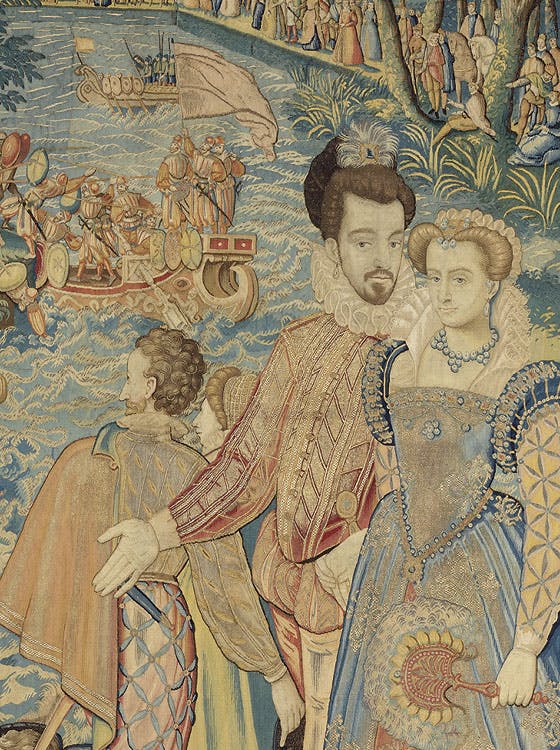
Renaissance Splendor
Tags for: Renaissance Splendor
- Magazine Article
- Exhibitions
Catherine de' Medici's newly restored Valois Tapestries make their debut
Marjorie E. Wieseman, Paul J. and Edith Ingalls Vignos Jr. Curator of European Paintings and Sculpture, 1500–1800
October 19, 2018
Appears in Cleveland Art, November/December 2018

Fontainebleau (detail), c. 1576. Woven under the direction of Master WF, Brussels. 395.5 x 338 cm. Arazzi n. 473
The Cleveland Museum of Art is the sole venue for an exhibition of major international significance. Renaissance Splendor: Catherine de’ Medici’s Valois Tapestries celebrates the loan of six magnificent wall-sized tapestries and other precious objects from the Gallerie degli Uffizi in Florence. The tapestries, commissioned around 1575 by Catherine de’ Medici (wife of Henri II, king of France), feature likenesses of courtiers and family members standing before remarkably detailed depictions of court festivities. After Catherine’s death, the tapestries passed to her granddaughter, Christina of Lorraine, who brought them to Florence in 1589 when she married Ferdinand I de’ Medici. The CMA has partnered with the Uffizi to organize this exhibition, which reveals the completed conservation of these unique tapestries and situates them within the artistic, social, and political environment of the French Valois court. Born in Florence, Catherine traveled to Paris at age 14 to become the wife of Henri, son of François I, king of France. Henri became king upon the death of his father in 1547; he died just 12 years later as the result of a tragic accident during a jousting match. After Henri’s death, Catherine devoted herself to ensuring the continued dominance of Henri’s family—the Valois—on behalf of their children and subsequent generations. Political machinations or strategic marital alliances could achieve this goal, but an equally effective way of demonstrating the might of the Valois dynasty was to impress both French subjects and foreign nations with the splendor and extravagance of life at court. Catherine built magnificent palaces and amassed an impressive art collection; several works that she personally owned are featured in the exhibition, including jewels, decorative vessels carved from semiprecious stone, and portraits of family members.
Image

Contemporaries were particularly awed by the grand celebrations called “magnificences” that Catherine periodically hosted, usually to mark a family reunion, diplomatic visit, or political event. Extending over several days, the “magnificence” typically featured music, dance, theatrical performances, fireworks, and martial enactments in elaborate, specially constructed settings. The fact that they were by their very nature ephemeral may be a key reason why Catherine opted to commemorate these impressive (and massively expensive) events in a series of grand tapestries. In the 1500s, tapestries were by far the most highly regarded and costly art form, and Catherine spared no expense in the production of the hangings now known as the Valois Tapestries. The designs were based on drawings by two of the most skilled artists in Catherine’s employ: Antoine Caron and François Clouet. Caron’s sketches of various royal “magnificences” reappear at the center of the tapestries, flanked in the foreground by life-size portrait figures of Valois family members and high-ranking courtiers, based on likenesses drawn by Clouet. Several of the drawings by Caron and Clouet will be displayed adjacent to the tapestries they inspired. The tapestries themselves were woven not in France but in Brussels, a city renowned throughout Europe for the skill of its tapestry workers. The quality of their work—and the expense of the materials used—is particularly evident in the silver and gilded silver metal-wrapped threads that create rich texture and shimmering effects throughout the Valois Tapestries. The enormous scale of the hangings—about 14 feet high—means that the foreground figures are roughly life-size; they act as interlocutors between the viewer and the events transpiring within each tapestry. They invite us to witness the marvels staged by Catherine and the artists, writers, musicians, and performers in her employ: an attack on a fantastic mechanical whale, a tournament of knights on horseback, or Apollo and the muses serenading dancers and visiting dignitaries from atop an artificial “mountain.” Catherine herself—always clad in black mourning dress—appears in each tapestry as a reminder of her central role in each “magnificence” and of her unwavering determination to secure continued Valois rule.
Despite those efforts, the Valois monarchy ended in 1589 with the assassination of Catherine’s son Henri III, king of France, mere months after her own death. Also in that year, the Valois Tapestries left Paris and became part of the Medici family collections in Florence. In 1737 these collections became the property of the state, and the tapestries found their way to the Gallerie degli Uffizi, where they are housed today. Although the hangings were a treasured part of the collection, 450 years of exposure to dirt, light, and other environmental factors inevitably wreaked damage and degradation upon delicate fibers and light-sensitive dyes. In the late 1990s, a comprehensive conservation survey was undertaken to assess how to address these issues. The conservation protocol included cleaning the tapestries and removing oxidation from the metal-wrapped threads; stabilizing sewn elements and reweaving to restore or reinforce areas of damage, degradation, or loss; and attaching a secure lining and hanging devices to the reverse of each tapestry. Six of the eight Valois Tapestries have been conserved and can be seen at the Cleveland Museum of Art—for the first time anywhere—in all their brilliance.
Cleveland Art, November/December 2018
Related Content
Renaissance Splendor: Catherine de’ Medici’s Valois Tapestries
Tags for: Renaissance Splendor: Catherine de’ Medici’s Valois Tapestries
- Special Exhibition
On view for the first time in North America, the recently restored Valois Tapestries, a unique set of 16th-century hangings,...
